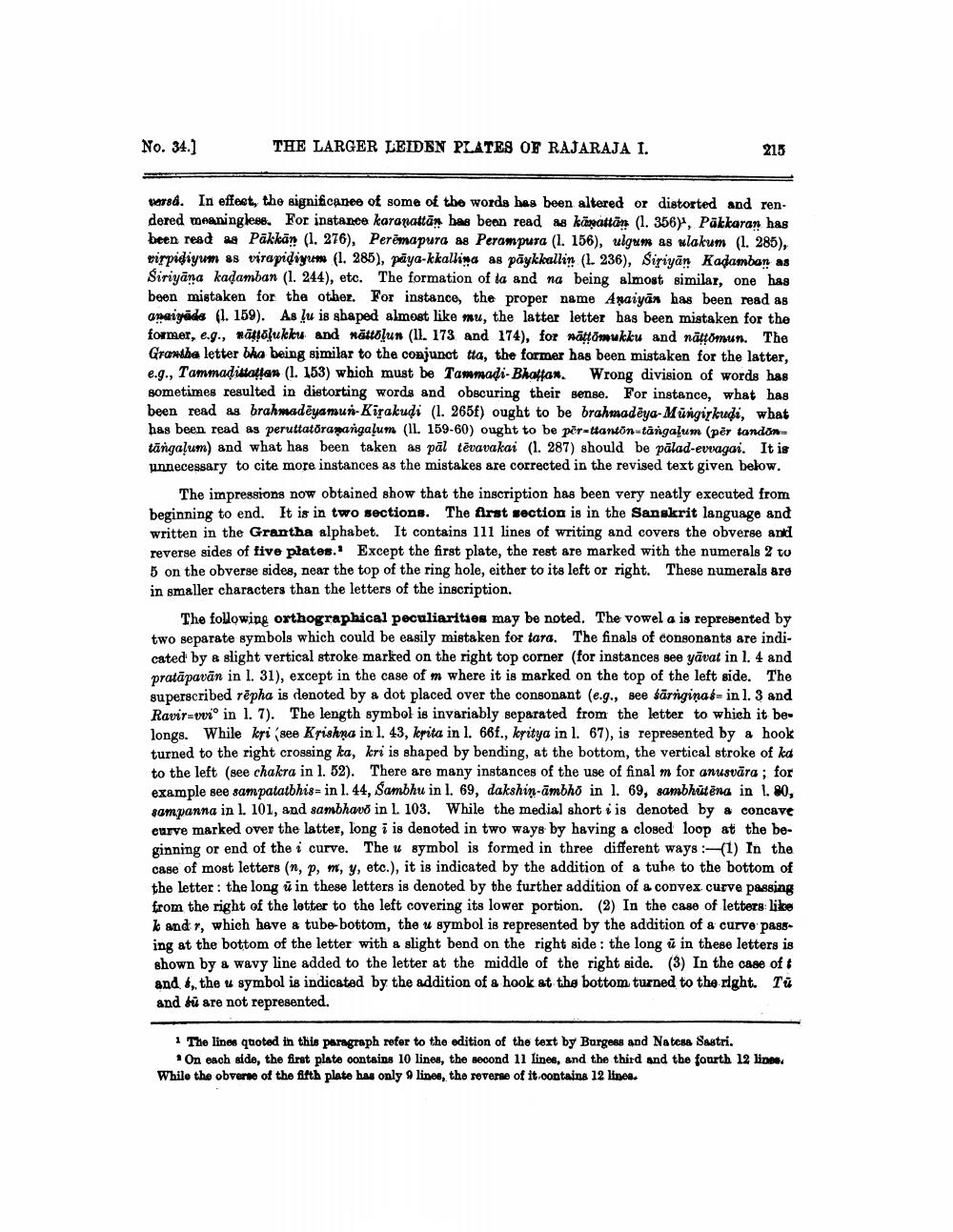________________
No. 34.1
THE LARGER LEIDEN PLATES OF RAJARAJA I.
215
versa. In effect, the significance of some of the words has been altered or distorted and rendered meaningless. For instance karanattan has been read as kanattan (1. 356), Päkkaran has been read as Päkkän (1. 276), Peremapura as Perampura (1. 156), ulgum as ulakum (1. 285), virpidiyum as virapidiyum (1. 285), paya-kkallina as päykkallin (1. 236), Siriyān Kadamban as Siriyana kadamban (1. 244), etc. The formation of ta and na being almost similar, one has been mistaken for the other. For instance, the proper name Anaiyan has been read as apsiyada (1. 159). As lu is shaped almost like mu, the latter letter has been mistaken for the former, e.g., mätöļukku and nättölun (11. 173 and 174), for näṭṭomukku and näṭṭömun. The Granthe letter bha being similar to the conjunct tta, the former has been mistaken for the latter, e.g., Tammaḍistattan (1. 153) which must be Tammadi-Bhattan. Wrong division of words has sometimes resulted in distorting words and obscuring their sense. For instance, what has been read as brahmadeyamun-Kirakudi (1. 265f) ought to be brahmadeya-Mungirkudi, what has been read as peruttatoramangalum (11. 159-60) ought to be per-ttanton tāngalum (per tandontāngalum) and what has been taken as pal tēvavakai (1. 287) should be palad-evvagai. It is unnecessary to cite more instances as the mistakes are corrected in the revised text given below.
The impressions now obtained show that the inscription has been very neatly executed from beginning to end. It is in two sections. The first section is in the Sanskrit language and written in the Grantha alphabet. It contains 111 lines of writing and covers the obverse and reverse sides of five plates. Except the first plate, the rest are marked with the numerals 2 to 5 on the obverse sides, near the top of the ring hole, either to its left or right. These numerals are in smaller characters than the letters of the inscription.
The following orthographical peculiarities may be noted. The vowel a is represented by two separate symbols which could be easily mistaken for tara. The finals of consonants are indicated by a slight vertical stroke marked on the right top corner (for instances see yāvat in 1. 4 and pratāpavān in 1. 31), except in the case of m where it is marked on the top of the left side. The superscribed repha is denoted by a dot placed over the consonant (e.g., see särnginas in 1. 3 and Ravir-vvi in 1. 7). The length symbol is invariably separated from the letter to which it be longs. While kri (see Krishna in 1. 43, krita in l. 66f., kritya in l. 67), is represented by a hook turned to the right crossing ka, kri is shaped by bending, at the bottom, the vertical stroke of ka to the left (see chakra in 1. 52). There are many instances of the use of final m for anusvara; for example see sampatatbhis= in 1. 44, Sambhu in l. 69, dakshin-ambhō in 1. 69, sambhūtēna in 1. 80, sampanna in l. 101, and sambhavo in l. 103. While the medial short i is denoted by a concave curve marked over the latter, long i is denoted in two ways by having a closed loop at the beginning or end of the i curve. The u symbol is formed in three different ways: (1) In the case of most letters (n, p, m, y, etc.), it is indicated by the addition of a tube to the bottom of the letter: the long u in these letters is denoted by the further addition of a convex curve passing from the right of the letter to the left covering its lower portion. (2) In the case of letters like k and r, which have a tube-bottom, the u symbol is represented by the addition of a curve passing at the bottom of the letter with a slight bend on the right side: the long u in these letters is shown by a wavy line added to the letter at the middle of the right side. (3) In the case of t and &,, the u symbol is indicated by the addition of a hook at the bottom turned to the right. Tü and éu are not represented.
1 The lines quoted in this paragraph refer to the edition of the text by Burgess and Natesa Sastri.
On each side, the first plate contains 10 lines, the second 11 lines, and the third and the fourth 12 lines. While the obverse of the fifth plate has only 9 lines, the reverse of it contains 12 lines.




